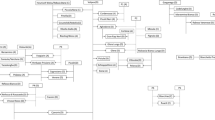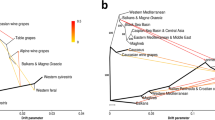Abstract
The world's great wines are produced from a relatively small number of classic European cultivars of Vitis vinifera L Most are thought to be centuries old and their origins have long been the subject of speculation1,2. Among the most prominent of these cultivars is Cabernet Sauvignon, described as “the world's most renowned grape variety for the production of fine red wine”3. Although now grown in many countries, Cabernet Sauvignon derives its fame from its long association with the Bordeaux region of France, where it has been grown at least since the 17th century4. We present microsatellite DNA evidence for the hypothesis that Cabernet Sauvignon is the progeny of two other Bordeaux cultivars, Cabernet franc and Sauvignon blanc. Likelihood ratios support this hypothesis to a very high degree of probability. A close relationship between Cabernet Sauvignon and Cabernet franc has been suspected but the genetic contribution of Sauvignon blanc, despite its similar name, is a surprise.
This is a preview of subscription content, access via your institution
Access options
Subscribe to this journal
Receive 12 print issues and online access
$209.00 per year
only $17.42 per issue
Buy this article
- Purchase on Springer Link
- Instant access to full article PDF
Prices may be subject to local taxes which are calculated during checkout
Similar content being viewed by others
References
Levadoux, L. Les populations sauvages et cultivées de Vitis vinifera L. Annales de I'Amélioration des Plantes 6, 59–118 (1956).
Bouquet, A. Origine et évolution de l'encépagement francais à travers les siécles. Le progress agricole et viticole 99, 110–121 (1982).
Robinson, J. The Oxford Companion to Wine.(Oxford University Press, Oxford,1994).
Viala, P. & Vermorel, V. Ampélographie, Tome II.(Masson, Paris,1901).
Thomas, M.R. & Scott, N.S. Microsatellite repeats in grapevine reveal DNA polymorphisms when analysed as sequence-tagged sites (STSs). Theor. Appl.Genet. 86, 985–990 (1993).
Bowers, J.E., Dangl, G.S.,& Meredith, C.P. Isolation and characterization of new polymorphic simple sequence repeat loci in grape (Vitis vinifera L). Genome 39, 628–633 (1996).
Thomas, M.R., Cain, P. & Scott, N.S. DNA typing of grapevines: A universal methodology and database for describing cultivars and evaluating genetic relatedness. Plant Mol. Biol. 25, 939–949 (1994).
Weir, B.S. Genetic Data Analysis II. (Sinauer Associates, Inc., Sunderland,Massachusetts,1996).
Hagelberg, E., Gray, I.C. & Jeffreys, A.J. Identification of the skeletal remains of amurder victim by DNA analysis. Nature 352, 427–429 (1991).
Bowers, J.E., Sandman, E.B. & Meredith, C.P. DNA fingerprint characterization of some California winegrape cultivars. Amer. J. Enol. Vitic. 44, 266–274 (1993).
Bowers, J.E. DNA fingerprinting analysis of some winegrape cultivars. M.S. thesis.(University of California, Davis,1993).
Bourquin, J.C., Sonko, A., Otten, L. & Walter, B. Restriction fragment length polymorphism and molecular taxonomy inVitis vinifera L. Theoret. Appl. Genet 87, 431–438 (1993).
Wolfe, W.H. Identification of grape varieties by isozyme banding patterns. Amer. J. Enol. Vitic. 27, 68–73 (1976).
Parfitt, D.E. & Arulsekar, S. Inheritance and isozyme diversity for GPI and PGM among grape cultivars. J. Amer. Soc. Hort. Sci. 114, 486–491 (1989).
Hudson, T.J. et al. Isolation and chromosomal assignment of 100 highly informative human simple sequence repeat polymorphisms. Genomics 13, 622–629 (1992).
Galet, P. Cépages et Vignobles de France. Tome II. L'ampélographie Francaise. (Imprimerie Charles Dehan, Montpellier, France,1990).
Sturtevant, A.M. A History of Genetics.(Harper and Row, New York,1965).
Rives, M. Bases gènètiques de la sélection clonale chez la vigne. Ann. Amelior. Plantes 11, 337–348 (1961).
Author information
Authors and Affiliations
Corresponding author
Rights and permissions
About this article
Cite this article
Bowers, J., Meredith, C. The parentage of a classic wine grape, Cabernet Sauvignon. Nat Genet 16, 84–87 (1997). https://doi.org/10.1038/ng0597-84
Received:
Accepted:
Issue Date:
DOI: https://doi.org/10.1038/ng0597-84



